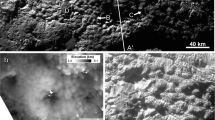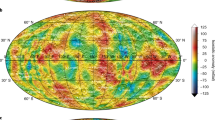Abstract
Cryovolcanism, defined here as the extrusion of icy material from depth, may be an important planetary phenomenon in shaping the surfaces of many worlds in the outer Solar System and revealing their thermal histories1,2,3. However, the physics, chemistry and ubiquity of this geologic process remain poorly understood, especially in comparison to the better-studied silicate volcanism on the terrestrial planets. Ceres is the only plausibly cryovolcanic world to be orbited by a spacecraft up to now, making it the best opportunity to test the importance of cryovolcanism on bodies in the outer Solar System and compare its effects to silicate volcanism on terrestrial planets. Here, we analyse images from NASA’s Dawn mission4 and use the finite element method to show that Ceres has experienced cryovolcanism throughout its geologic history, with an average cryomagma extrusion rate of ~104 m3 yr−1. This result shows that volcanic phenomena are important on Ceres, but orders of magnitude less so than on the terrestrial planets.
This is a preview of subscription content, access via your institution
Access options
Access Nature and 54 other Nature Portfolio journals
Get Nature+, our best-value online-access subscription
$29.99 / 30 days
cancel any time
Subscribe to this journal
Receive 12 digital issues and online access to articles
$119.00 per year
only $9.92 per issue
Buy this article
- Purchase on Springer Link
- Instant access to full article PDF
Prices may be subject to local taxes which are calculated during checkout



Similar content being viewed by others
Data availability
The data that support the plots within this paper and other findings of this study are available from the corresponding author upon reasonable request. The data come from NASA’s Dawn mission and are also publically available in the NASA Planetary Data System (https://pds.nasa.gov).
Change history
18 October 2018
In the version of this Letter originally published, the unit in the right y axis label in Fig. 3 mistakenly read ‘(m yr–1)’; it has now been corrected to read ‘(m Myr–1)’.
References
Kargel, J. S. Brine volcanism and the interior structures of asteroids and icy satellites. Icarus 94, 368–390 (1991).
Schenk, P. M., McKinnon, W. B., Gwynn, D. & Moore, J. M. Flooding of Ganymede’s bright terrains by low-viscosity water-ice lavas. Nature 410, 57–60 (2001).
Quick, L. C., Glaze, L. S. & Baloga, S. M. Cryovolcanic emplacement of domes on Europa. Icarus 284, 477–499 (2017).
Russell, C. T. et al. Dawn arrives at Ceres: exploration of a small, volatile-rich world. Science 353, 1008–1010 (2016).
Ruesch, O. et al. Cryovolcanism on Ceres. Science 353, aaf4286 (2016).
Sori, M. M. et al. The vanishing cryovolcanoes of Ceres. Geophys. Res. Lett. 44, 1243–1250 (2017).
Bland, M. T. et al. Composition and structure of the shallow subsurface of Ceres revealed by crater morphology. Nature Geosci. 9, 528–542 (2016).
Fu, R. R. et al. The interior structure of Ceres as revealed by surface topography. Earth. Planet. Sci. Lett. 476, 153–164 (2017).
Buczkowski, D. L. et al. The geomorphology of Ceres. Science 353, aaf4332 (2016).
Park, R. S. et al. A partially differentiated interior for (1) Ceres deduced from its gravity field and shape. Nature 537, 515–517 (2016).
Williams, D. A. et al. Introduction: the geologic mapping of Ceres. Icarus https://doi.org/10.1016/j.icarus.2017.05.004 (2018).
Greeley, R. & Spudis, P. D. Volcanism on Mars. Rev. Geophys. Space Phys. 19, 13–41 (1981).
Stein, N. T. et al. The formation and evolution of bright spots on Ceres. Icarus https://doi.org/10.1016/j.icarus.2017.10.014 (2018).
Goldsby, D. L. & Kohlstedt, D. L. Superplastic deformation of ice: experimental observations. J. Geophys. Res. 106, 11017–11030 (2001).
Durham, W. B., Pathare, A. V., Stern, L. A. & Lenferink, H. J. Mobility of icy sand packs, with application to Martian permafrost. Geophys. Res. Lett. 36, L23203 (2009).
Bramson, A. M., Byrne, S. & Bapst, J. Preservation of midlatitude ice sheets on Mars. J. Geophys. Res. Planets 122, 2250–2266 (2017).
Zambon, F. et al. Spectral analysis of Ahuna Mons from Dawn mission’s visible-infrared spectrometer. Geophys. Res. Lett. 44, 97–104 (2017).
Ruesch, O. et al. Geology of Ceres’ north pole quadrangle with Dawn FC imaging data. Icarus https://doi.org/10.1016/j.icarus.2017.09.036 (2018).
Bland, M. T. et al. Why is Ceres lumpy? Surface deformation induced by solid-state subsurface flow. In 49th Lunar and Planetary Science Conference 1627 (LPI, 2018).
Golombek, M. P. et al. Small crater modification on Meridiani Planum and implications for erosion rates and climate change on Mars. J. Geophys. Res. Planets 119, 2522–2547 (2014).
Fassett, C. I. et al. Evidence for rapid topographic evolution and crater degradation on Mercury from simple crater morphometry. Geophys. Res. Lett. 44, 5326–5335 (2017).
Platz, T. et al. Geological mapping of the Ac-10 Rongo quadrangle of Ceres. Icarus https://doi.org/10.1016/j.icarus.2017.08.001 (2018).
Marchi, S. et al. The missing large impact craters on Ceres. Nat. Commun. 7, 12257 (2016).
De Sanctis, M. C. et al. Bright carbonate deposits as evidence of aqueous alteration on (1) Ceres. Nature 536, 54–57 (2016).
Ruesch, O. et al. Bright carbonate surfaces on Ceres as remnants of salt-rich water fountains. Icarus https://doi.org/10.1016/j.icarus.2018.01.022 (2018).
Quick, L. C. et al. A possible brine reservoir beneath Occator crater: thermal and composition evolution and formation of the Cerealia dome and Vinalia Faculae. Icarus https://doi.org/10.1016/j.icarus.2018.07.016 (2018).
Nathues, A. et al. Evolution of Occator crater on (1)Ceres. Astron. J. 153, 112 (2017).
Taisne, B. & Jaupart, C. Magma degassing and intermittent lava dome growth. Geophys. Res. Lett. 35, L20310 (2008).
Sori, M. M., Zuber, M. T., Head, J. W. & Kiefer, W. S. Gravitational search for cryptovolcanism on the Moon: evidence for large volumes of early igneous activity. Icarus 273, 284–295 (2016).
Crisp, J. A. Rates of magma emplacement and volcanic output. J. Volcanol. Geotherm. Res. 20, 177–211 (1984).
Grimm, R. E. & Solomon, S. C. Limits on modes of lithospheric heat transport on Venus from impact crater density. Geophys. Res. Lett. 14, 538–541 (1987).
Head, J. W. & Wilson, L. Lunar mare volcanism: stratigraphy, eruption conditions, and the evolution of secondary crusts. Geochem. Cosmochim. Acta 56, 2155–2175 (1992).
Greeley, R. & Schneid, B. D. Magma generation on Mars: amounts, rates, and comparisons with Earth, Moon, and Venus. Science 254, 996–998 (1991).
Zahnle, K., Alvarellos, J. A., Dobrovolskis, A. & Hamill, P. Secondary and sesquinary craters on Europa. Icarus 194, 660–674 (2008).
Gross, P., van Wyk de Vries, B., Euillades, P. A., Kervyn, M. & Petrinovic, I. A. Systematic morphometric characterization of volcanic edifices using digital elevation models. Geomorphology 136, 114–131 (2012).
Euillades, L. D., Grosse, P. & Euillades, P. A. NETVOLC: an algorithm for automatic delimitation of volcano edifice boundaries using DEMs. Comput. Geosci. 56, 151–160 (2013).
Ermakov, A. I. et al. Constraints on Ceres’ internal structure and evolution from its shape and gravity measured by the Dawn spacecraft. J. Geophys. Res. Planets 122, 2267–2293 (2017).
Gagliardini, O. et al. Capabilities and performance of Elmer/Ice, a new-generation ice sheet model. Geosci Model Dev. 6, 1299–1318 (2013).
Sori, M. M., Byrne, S., Hamilton, C. W. & Landis, M. E. Viscous flow rates of icy topography on the north polar layered deposits of Mars. Geophys. Res. Lett. 43, 541–549 (2016).
McCarthy, C., Cooper, R. F., Goldsby, D. L., Durham, W. B. & Kirby, S. H. Transient and steady state creep response of ice I and magnesium sulfate hydrate eutectic aggregates. J. Geophys. Res. 116, E04007 (2011).
Durham, W. B., Kirby, S. H. & Stern, L. A. Effects of dispersed particulates on the rheology of water ice at planetary conditions. J. Geophys. Res. 97, 20833–20897 (1992).
Durham, W. B., Stern, L. A., Kubo, T. & Kirby, S. H. Flow strength of highly hydrated Mg- and Na-sulfate hydrate salts, pure and in mixtures with water ice, with application to Europa. J. Geophys. Res. 110, E12010 (2005).
Wieczorek, M. A. et al. The crust of the Moon as seen by GRAIL. Science 339, 671–675 (2013).
Soderblom, J. M. et al. The fractured Moon: production and saturation of porosity in the lunar highlands from impact cratering. Geophys. Res. Lett. 42, 6939–6944 (2015).
Castillo-Rogez, J. C. et al. Ceres' geophysical evolution inferred from Dawn data. AAS/Division for Planet. Sci. 48, 407.05 (2016).
Ermakov, A. I. et al. Ceres’s obliquity history and its implications for the permanently shadowed regions. Geophys. Res. Lett. 44, 2652–2661 (2017).
Acknowledgements
M.M.S., S.B., H.G.S. and M.T.B. acknowledge support from the National Aeronautics and Space Administration (NASA) Dawn Guest Investigator Program. Any use of trade, firm or product names is for descriptive purposes only and does not imply endorsement by the US Government.
Author information
Authors and Affiliations
Contributions
M.M.S. formulated the project, performed all viscous flow model runs and led writing of this paper. M.M.S. and H.G.S. identified and analysed the domes suitable for this study. A.M.B. performed the thermal model runs. All authors contributed substantially to the interpretation of results and writing of this paper.
Corresponding author
Ethics declarations
Competing interests
The authors declare no competing interests.
Additional information
Publisher’s note: Springer Nature remains neutral with regard to jurisdictional claims in published maps and institutional affiliations.
Supplementary information
Supplementary Information
Supplementary Tables 1 and 2
Rights and permissions
About this article
Cite this article
Sori, M.M., Sizemore, H.G., Byrne, S. et al. Cryovolcanic rates on Ceres revealed by topography. Nat Astron 2, 946–950 (2018). https://doi.org/10.1038/s41550-018-0574-1
Received:
Accepted:
Published:
Issue Date:
DOI: https://doi.org/10.1038/s41550-018-0574-1
This article is cited by
-
Volcanism in the Solar System
Science China Earth Sciences (2023)
-
GAUSS - genesis of asteroids and evolution of the solar system
Experimental Astronomy (2021)
-
Evidence of non-uniform crust of Ceres from Dawn’s high-resolution gravity data
Nature Astronomy (2020)
-
Post-impact cryo-hydrologic formation of small mounds and hills in Ceres’s Occator crater
Nature Geoscience (2020)
-
Fresh emplacement of hydrated sodium chloride on Ceres from ascending salty fluids
Nature Astronomy (2020)



